Solar eclipse of September 10, 1923
| Solar eclipse of September 10, 1923 | |
|---|---|
| Type of eclipse | |
| Nature | Total |
| Gamma | 0.5149 |
| Magnitude | 1.043 |
| Maximum eclipse | |
| Duration | 217 s (3 min 37 s) |
| Coordinates | 34°42′N 121°48′W / 34.7°N 121.8°W |
| Max. width of band | 167 km (104 mi) |
| Times (UTC) | |
| Greatest eclipse | 20:47:29 |
| References | |
| Saros | 143 (18 of 72) |
| Catalog # (SE5000) | 9335 |
A total solar eclipse occurred on September 10, 1923. A solar eclipse occurs when the Moon passes between Earth and the Sun, thereby totally or partly obscuring the image of the Sun for a viewer on Earth. A total solar eclipse occurs when the Moon's apparent diameter is larger than the Sun's, blocking all direct sunlight, turning day into darkness. Totality occurs in a narrow path across Earth's surface, with the partial solar eclipse visible over a surrounding region thousands of kilometres wide.
The path of totality started at the southeastern tip of Shiashkotan in Japan (now in Russia) on September 11, and crossed the Pacific Ocean, southwestern California including the whole Channel Islands, northwestern and northern Mexico, Yucatan Peninsula, British Honduras (today's Belize), Swan Islands, Honduras, and Serranilla Bank and Bajo Nuevo in Colombia on September 10. The eclipse was over 90% in Los Angeles, San Diego and Santa Barbara in the Southern California coast.
Related eclipses
Solar eclipses of 1921–1924
This eclipse is a member of a semester series. An eclipse in a semester series of solar eclipses repeats approximately every 177 days and 4 hours (a semester) at alternating nodes of the Moon's orbit.[1]
| Solar eclipse series sets from 1921 to 1924 | ||||
|---|---|---|---|---|
| Descending node | Ascending node | |||
| 118 | April 8, 1921 Annular |
123 | October 1, 1921 Total | |
| 128 | March 28, 1922 Annular |
133 | September 21, 1922 Total | |
| 138 | March 17, 1923 Annular |
143 | September 10, 1923 Total | |
| 148 | March 5, 1924 Partial |
153 | August 30, 1924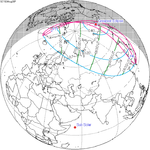 Partial | |
Solar 143
It is a part of Saros cycle 143, repeating every 18 years, 11 days, containing 72 events. The series started with partial solar eclipse on March 7, 1617 and total event from June 24, 1797 through October 24, 1995. It has hybrid eclipses from November 3, 2013 through December 6, 2067, and annular eclipses from December 16, 2085 through September 16, 2536. The series ends at member 72 as a partial eclipse on April 23, 2873. The longest duration of totality was 3 minutes, 50 seconds on August 19, 1887. All eclipses in this series occurs at the Moon’s ascending node.
| Series members 17–28 occur between 1741 and 2100 | ||
|---|---|---|
| 8 | 9 | 10 |
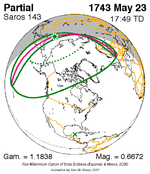 May 23, 1743 |
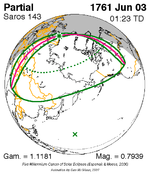 June 3, 1761 |
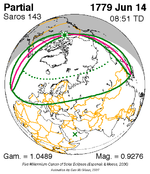 June 14, 1779 |
| 11 | 12 | 13 |
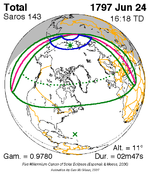 June 24, 1797 |
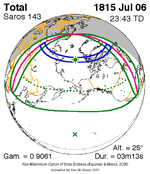 July 6, 1815 |
 July 17, 1833 |
| 14 | 15 | 16 |
 July 28, 1851 |
 August 7, 1869 |
 August 19, 1887 |
| 17 | 18 | 19 |
 August 30, 1905 |
 September 10, 1923 |
 September 21, 1941 |
| 20 | 21 | 22 |
 October 2, 1959 |
 October 12, 1977 |
 October 24, 1995 |
| 23 | 24 | 25 |
 November 3, 2013 |
 November 14, 2031 |
 November 25, 2049 |
| 26 | 27 | 28 |
 December 6, 2067 |
 December 16, 2085 | |
Notes
- ^ van Gent, R.H. "Solar- and Lunar-Eclipse Predictions from Antiquity to the Present". A Catalogue of Eclipse Cycles. Utrecht University. Retrieved 6 October 2018.
References
- Earth visibility chart and eclipse statistics Eclipse Predictions by Fred Espenak, NASA/GSFC
- Foto and sketchs of Solar Corona September 10, 1923




